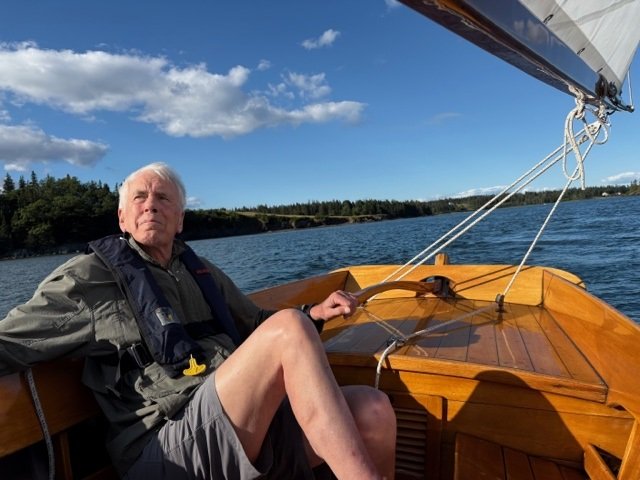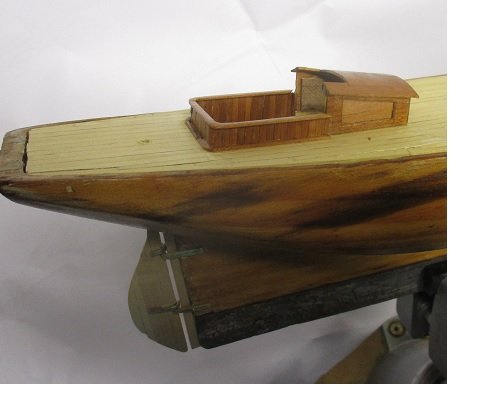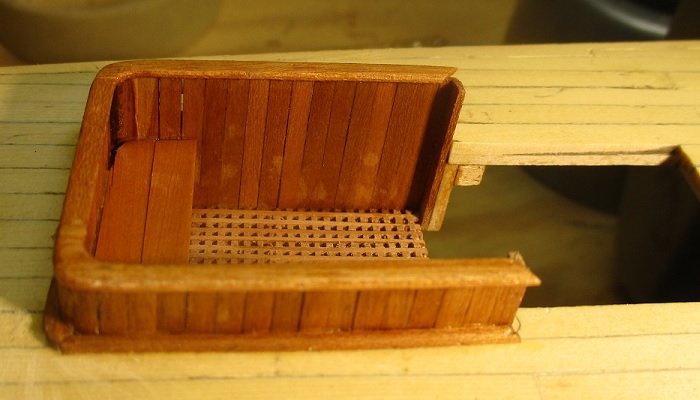-
Posts
1,308 -
Joined
-
Last visited
Content Type
Profiles
Forums
Gallery
Events
Everything posted by TBlack
-
I've been making a little progress, albeit fits and starts. The difficult part of the companionway hatch is behind me, and the rudder need staining. But the challenging parts, I think, are done. Although, in the bow is a winch which requires a gear and pawl. I know that the gear feature has been done many times, so I'll just copy if I can remember where they are on this site (?).
-

USF Essex by mtbediz - FINISHED - 1:50
TBlack replied to mtbediz's topic in - Build logs for subjects built 1801 - 1850
Mustafa, OK, I got it. What kind of wood do you use for the wheel? Tom, -

USF Essex by mtbediz - FINISHED - 1:50
TBlack replied to mtbediz's topic in - Build logs for subjects built 1801 - 1850
Mustafa, Recognizing the language barrier, I'll try to be brief. Your pictures of the wheel construction (post 49) start with the wheel (ring) already made. I'dlike to know how you made the wheel (ring). Tom Black -
I'll second the previous 2 posts in admiration of your skills. But more importantly, you show us how it's done. Tom
- 2,215 replies
-
Takes a remarkably steady hand with the jeweler's saw and the #4 file to get crisp straight edges. Incredible! Tom
- 2,215 replies
-

USF Essex by mtbediz - FINISHED - 1:50
TBlack replied to mtbediz's topic in - Build logs for subjects built 1801 - 1850
For me, the critical part is being able to make the wheel. Out of a solid piece of wood there will be cross grain, and no stability. So, dear Mustafa, how did you manage to deal with that? Tom -
Bob, You threw down a challenge and it was met and exceeded! Tom
- 2,215 replies
-

Are there any decent clamps?
TBlack replied to bigcreekdad's topic in Modeling tools and Workshop Equipment
So you need downward pressure against the wale and inward pressure against the frame/bulkhead. I use those alligator clips for the downward and elastic bands for the inward. Cheap and plentiful. Tom -

Are there any decent clamps?
TBlack replied to bigcreekdad's topic in Modeling tools and Workshop Equipment
How deep does the throat have to be for your needs? I use alligator clamps with the teeth filed down for detail clamping. -
I, too, have felt the loss of a treasured pet. But 20 years, not bad. Tyra was obviously loved and well cared for. God gave us these pets to love and who love us, and then their life span is so short that we have to watch them die. Life can be tough sometimes. TB
- 2,215 replies
-
After all this effort, I hope these cushions are visible in the final product. But they do look classy! Tom
- 2,215 replies
-
I like the new button pattern. Who knew you are also an interior decorator! Tom
- 2,215 replies
-
Michael, taking the interior cabinetry out of the boat and reassembling it must take a good part of the day! I'd go with all pigskin, better at sea. Tom
- 2,215 replies
-
"There is something intrinsically satisfying about being able to prepare ones own materials from the raw tree" This is a fabulous story. Thanks for sharing! Tom
- 2,215 replies
-
This may be a little late, but instead of tracing out the lines. Take the page you tore out. Scan it to your computer; open the paint app; open the file that has the scan; paint lets you flip the picture 180 degrees; save that. Now print out half as many copies as you have station lines of each file. Take each copy and slice down the middle and match it up with its corresponding copy. Now you have the station lines for each bulkhead at each station. No tracing! Tom
- 10 replies
-
- Packet Ship
- William Webb
-
(and 1 more)
Tagged with:
-
I'm hoping that when this is done, you'll invite all of us out for a sail. I'll bring the sextant. Tom
- 2,215 replies
-
I've noticed, pretty consistently, that boat lovers also love trains (realworkingsailor). How ever are you going to get all that wonderful work down below, and why would you want to do that anyway? Tom
- 2,215 replies
-

CA residue problem
TBlack replied to Doc James's topic in Painting, finishing and weathering products and techniques
I use Testors dullcote which provides a flat finish and will take care of your problem. Tom
About us
Modelshipworld - Advancing Ship Modeling through Research
SSL Secured
Your security is important for us so this Website is SSL-Secured
NRG Mailing Address
Nautical Research Guild
237 South Lincoln Street
Westmont IL, 60559-1917
Model Ship World ® and the MSW logo are Registered Trademarks, and belong to the Nautical Research Guild (United States Patent and Trademark Office: No. 6,929,264 & No. 6,929,274, registered Dec. 20, 2022)
Helpful Links
About the NRG
If you enjoy building ship models that are historically accurate as well as beautiful, then The Nautical Research Guild (NRG) is just right for you.
The Guild is a non-profit educational organization whose mission is to “Advance Ship Modeling Through Research”. We provide support to our members in their efforts to raise the quality of their model ships.
The Nautical Research Guild has published our world-renowned quarterly magazine, The Nautical Research Journal, since 1955. The pages of the Journal are full of articles by accomplished ship modelers who show you how they create those exquisite details on their models, and by maritime historians who show you the correct details to build. The Journal is available in both print and digital editions. Go to the NRG web site (www.thenrg.org) to download a complimentary digital copy of the Journal. The NRG also publishes plan sets, books and compilations of back issues of the Journal and the former Ships in Scale and Model Ship Builder magazines.





